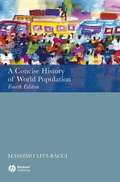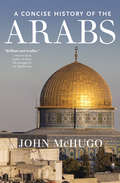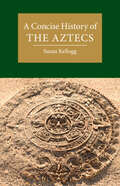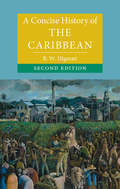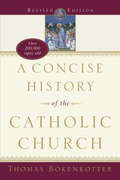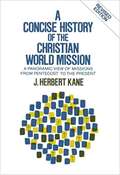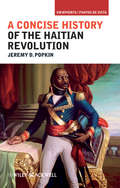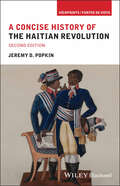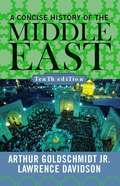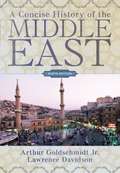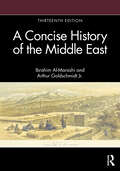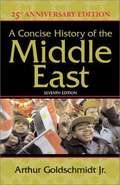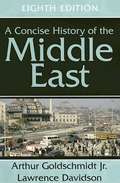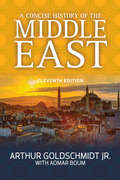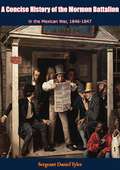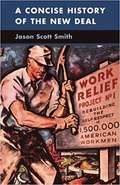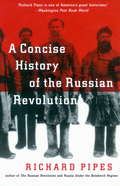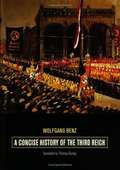- Table View
- List View
A Concise History of World Population (4th edition)
by Massimo Livi BacciThe new edition of this standard history of world population has been updated to include projections to the year 2050. It includes the latest data on fertility and infant mortality and a new section on migration has been added. The discussion of America is completely rewritten to give a fuller view of the past, including reference to the slave trade, and coverage of China has been expanded. Includes new sections on migration - an emerging issue for rich and poor countries alike - and the impact of HIV. Provides the latest data on fertility and infant mortality. Discussion of America is completely rewritten to give a fuller view of the past, including reference to the slave trade, and coverage of China has been expanded. Updates the quantitative material and bibliography.
A Concise History of the American Republic
by Henry Steele Commager Samuel Eliot Morison William E. LeuchtenburgA Concise History of the American Republic is a shortened and revised edition of The Growth of the American Republic, which first appeared in 1930. Over the next three decades, the two senior authors brought out four more editions. In the fifth edition, which appeared in 1962, Morison was responsible for the period up to the Civil War, and for the chapters on World War II ; Commager for the period since 1860, except for the chapters on World War II.
A Concise History of the Arabs
by John McHugoThis &“brilliant and erudite&” history by the award-winning Arabist provides vital context for understanding the contemporary Middle East (Patrick Seale, author of Asad: The Struggle for the Middle East). From Algeria and Libya to Egypt, Syria, and Saudi Arabia, the Arab world commands Western headlines. Nowhere else does the unfolding of events have such significant consequences for America. And yet its complex politics and cultures elude the grasp of most Western readers and commentators. A Concise History of the Arabs provides an essential road map to understanding the Arab world today, and in the years ahead. Noted Arab scholar John McHugo guides readers through the political, social, and intellectual history of the Arabs from the Roman Empire to the present day. Taking readers beyond the headlines, McHugo vividly describes the crucial turning points in Arab history—from the Prophet Muhammad&’s mission and the expansion of Islam to the region&’s interaction with Western ideas and the rise of Islamism. This lucidly told history reveals how the Arab world came into its present form, why major shifts like the Arab Spring were inevitable, and what may lie ahead for the region. A Choice Outstanding Academic Title, this accessible history is &“the product of wide reading, hard thinking and years of direct experience of the Middle East . . . There are lively and informative insights on almost every page&” (Patrick Seale, author of Asad: The Struggle for the Middle East).
A Concise History of the Aztecs (Cambridge Concise Histories)
by Susan KelloggSusan Kellogg's history of the Aztecs offers a concise yet comprehensive assessment of Aztec history and civilization, emphasizing how material life and the economy functioned in relation to politics, religion, and intellectual and artistic developments. Appreciating the vast number of sources available but also their limitations, Kellogg focuses on three concepts throughout – value, transformation, and balance. Aztecs created value, material, and symbolic worth. Value was created through transformations of bodies, things, and ideas. The overall goal of value creation and transformation was to keep the Aztec world—the cosmos, the earth, its inhabitants—in balance, a balance often threatened by spiritual and other forms of chaos. The book highlights the ethnicities that constituted Aztec peoples and sheds light on religion, political and economic organization, gender, sexuality and family life, intellectual achievements, and survival. Seeking to correct common misperceptions, Kellogg stresses the humanity of the Aztecs and problematizes the use of the terms 'human sacrifice', 'myth', and 'conquest'.
A Concise History of the Baltic States
by Andrejs PlakansThe Baltic region is frequently neglected in broader histories of Europe and its international significance can be obscured by separate treatments of the various Baltic states. With this wide-ranging survey, Andrejs Plakans presents an integrated history of three Baltic peoples - Estonians, Latvians and Lithuanians - and draws out the common threads to show how it has been shaped by their location in a strategically desirable corner of Europe. Subordinated in turn by Baltic German landholders, the Polish nobility and gentry, and then by Russian and Soviet administrators, the three nations have nevertheless kept their distinctive identities - significantly retaining three separate languages in an ethnically diverse region. The book traces the countries' evolution from their ninth-century tribal beginnings to their present status as three thriving and separate nation states, focusing particularly on the region's complex twentieth-century history, which culminated in the eventual re-establishment of national sovereignty after 1991.
A Concise History of the Caribbean
by B. W. HigmanA Concise History of the Caribbean presents a general history of the Caribbean islands from the beginning of human settlement about seven thousand years ago to the present. It narrates processes of early human migration, the disastrous consequences of European colonization, the development of slavery and the slave trade, the extraordinary profits earned by the plantation economy, the great revolution in Haiti, movements toward political independence, the Cuban Revolution, and the diaspora of Caribbean people. Written in a lively and accessible style yet current with the most recent research, the book provides a compelling narrative of Caribbean history essential for students and visitors.
A Concise History of the Caribbean (Cambridge Concise Histories)
by B. W. HigmanA Concise History of the Caribbean offers a comprehensive interpretation of the history of the Caribbean islands from the beginning of human settlement to the present. It narrates processes of early human migration, the disastrous consequences of European colonisation, the development of slavery and the slave trade, the extraordinary profits earned by the plantation economy, the great revolution in Haiti, movements towards political independence, the Cuban Revolution, and the diaspora of Caribbean people. In this second edition, Higman covers the political, social, and environmental developments of the last decade, offering sections on insular politics, Cuban communism, earthquakes, hurricanes, climate change, resource ecologies, epidemics, identity and reparations. Written in a lively and accessible style, and current with the most recent research, the book provides a compelling narrative of Caribbean history essential for students and visitors.
A Concise History of the Catholic Church
by Thomas BokenkotterA Concise History of the Catholic Church, first published by Image Books in 1979, has been one of the bestselling religious histories of the past two decades. Long a mainstay for scholars, students, and others looking for a definitive, accessible history of Catholicism, it has now been meticulously expanded and updated for the new millennium. With a clarity and conciseness that will appeal to the general reader, Thomas Bokenkotter divides his study into five parts that correspond to the major historical and epochal developments in Catholicism. His authoritative, thorough approach takes readers from the Church's triumph over paganism, through "the sound and fury of renewal," to a new section devoted to such topics as dissent, current developments in the ecumenical movement, and liberation theology. Informative illustrations throughout the book, new to this edition, enrich the reader's experience, and the addition of a wide-ranging bibliography increases its value as a sourcebook. A reviewer called the previous edition ofA Concise History of the Catholic Church"a tract for the times, an attempt to help bewildered Roman Catholics and others get some sense of the origins of all the change that has streamed through the windows by Vatican II. " This new edition reaffirms its importance in the library of ecumenical studies and confirms its place among the classics.
A Concise History of the Christian World Mission: A Panoramic View of Missions from Pentecost to the Present
by Herbert J. KaneAn excellent introductory survey of Christian missions from A.D. 30 to the twentieth century.
A Concise History of the Haitian Revolution (Viewpoints / Puntos de Vista #20)
by Jeremy D. PopkinThis book offers students a concise and clearly written overview of the events of the Haitian Revolution, from the slave uprising in the French colony of Saint-Domingue in 1791 to the declaration of Haiti’s independence in 1804. Draws on the latest scholarship in the field as well as the author’s original research Offers a valuable resource for those studying independence movements in Latin America, the history of the Atlantic World, the history of the African diaspora, and the age of the American and French revolutions Written by an expert on both the French and Haitian revolutions to offer a balanced view Presents a chronological, yet thematic, account of the complex historical contexts that produced and shaped the Haitian Revolution
A Concise History of the Haitian Revolution (Viewpoints / Puntos de Vista #20)
by Jeremy D. PopkinLearn about the first time in history that people of color overthrew a European colonial regime to establish an independent country Describing the only successful slave revolt in world history, the newly revised Second Edition of A Concise History of the Haitian Revolution delivers a nuanced and rigorous treatment of the events of the Haitian Revolution of the late 18th century and early 19th century. The book describes events from the slave uprising in the French colony of Saint-Domingue in 1791 and the emergence of its leader, Toussaint Louverture, to the declaration of independence by Jean-Jacques Dessalines in 1804. The new edition is updated to reflect the most recent scholarship in the field, including original research conducted by author Jeremy D. Popkin. It is a valuable resource for anyone studying independence movements in the Americas, the history of the Atlantic world, the history of the African diaspora, and the age of the American and French revolutions. Readers will also benefit from the inclusion of: The latest research on the subject of the Haitian Revolution, including new discoveries by the author and other scholars Coverage of the post-revolutionary period up to 1843, a period of intense interest in recent scholarship A clear and accessible approach to the subject that doesn’t assume or require any previous knowledge of this period in history Perfect for undergraduate students of history taking courses like the History of the Atlantic World, History of the Revolutionary Era, Latin American History to 1820, and History of the African Diaspora, A Concise History of the Haitian Revolution is also an ideal resource for high school teachers seeking a challenging resource for AP World History students.
A Concise History of the Hawaiian Islands
by Phil BarnesA very short history indeed, covering about 95 plus pages. It answers such questions as When did human habitation begin? Where were they from? How was family life organized? How did Hawai'i become a mix of the original inhabitants, Americans, Chinese, Portuguese, Japanese and others? How has life changed on Hawai'i from the beginning of human habitation to the present day? How have animals and plants fared? How many islands are there?
A Concise History of the Middle East
by Lawrence Davidson Arthur Goldschmidt Jr.The tenth edition of this widely acclaimed text by Arthur Goldschmidt Jr. and Lawrence Davidson has been revised to reflect the latest scholarship and the most recent events in the Middle East. As an introduction to the history of this turbulent region from the beginnings of Islam to the present day, the book is distinguished by its clear style, broad scope, and balanced treatment. It focuses on the evolution of Islamic institutions and culture, the influence of the West, the modernization efforts of Middle Eastern governments, the struggle of various peoples for political independence, the course of the Arab-Israeli conflict, the reassertion of Islamic values and power, the issues surrounding the Palestinian Question, and the roles of Iraq and Iran in the post-9/11 Middle East. The tenth edition includes a new chapter, "In the Season of Arab Discontent," that outlines the achievements and problems created by the recent Arab uprisings. In addition, earlier chapters have been streamlined for more accessible reading, and two popular study aids, the chronology and the glossary, have been revised. Resources for instructors are available online at www.westviewpress.com, including an updated bibliographic essay and test questions.
A Concise History of the Middle East
by Lawrence Davidson Arthur Goldschmidt Jr.The ninth edition of this widely acclaimed text by Arthur Goldschmidt Jr. and Lawrence Davidson has been extensively revised to reflect the latest scholarship and the most recent events in the Middle East.<P><P> As an introduction to the history of this turbulent region from the beginnings of Islam to the present day, the book is distinguished by its clear style, broad scope, and balanced treatment. It focuses on the evolution of Islamic institutions and culture, the influence of the West, the modernization efforts of Middle Eastern governments, the struggle of various peoples for political independence, the course of the Arab-Israeli conflict, the reassertion of Islamic values and power, the issues surrounding the Palestinian Question, and the roles of Iraq and Iran in the post-9/11 Middle East. Nine maps newly commissioned for the ninth edition highlight key aspects of Middle East history. Two popular study aids, the chronology and the glossary, have been extensively revised, and the superlative bibliographic essay, an essential guide to further reading, has been thoroughly rewritten to reflect current scholarship.
A Concise History of the Middle East
by Lawrence Davidson Arthur Goldschmidt Jr.The Arab Spring unexpectedly developed in late 2010 with peaceful protests in a number of Arab countries against long-standing, entrenched regimes, and rapid political change across the region ensued. The Arab Spring: Change and Resistance in the Middle East examines these revolutions and their aftermath. Noted authorities writing specifically for this volume contribute chapters focusing on countries directly or indirectly involved, illuminating the immediate and long-term impacts of the revolutions in the region and throughout the world. A thoughtful concluding chapter ties together key themes, while also delineating persistent myths and misinterpretations. This is an essential volume for students and scholars of the Middle East, as well as anyone seeking a fuller understanding of region and what may lie ahead. Resources for instructors are available online at westviewpress. com, including an updated bibliographic essay and test questions.
A Concise History of the Middle East
by Ibrahim Al-Marashi Arthur Goldschmidt Jr.A Concise History of the Middle East provides a comprehensive introduction to the history of this region. Spanning from the pre-Islamic era to the present, it explores the evolution of Middle Eastern institutions and culture, the influence of European colonialism and Western imperialism, regional modernization efforts, the struggle of various peoples for political independence, the Arab–Israeli conflict, the reassertion of Islamist values and power, the issues surrounding the Palestinian Question, and the Middle East following 9/11, the 2011 Arab uprisings, and the regional crisis that erupted after 7 October 2023.The thirteenth edition has been fully revised to reflect the most recent events in, and concerns of, the region, including its future in the face of climate change and challenges in Iraq, and developments in the Israeli–Palestinian conflict. In addition, the important role of Middle Eastern women in the history of the region is woven into the narrative. New parts and part timelines will help students grasp and contextualize the long and complicated history of the region.With updated biographical sketches and a new concluding chapter, this book remains the quintessential text for students of Middle East history.
A Concise History of the Middle East (10th edition)
by Lawrence Davidson Arthur Goldschmidt Jr.The tenth edition of this widely acclaimed text by Arthur Goldschmidt Jr. and Lawrence Davidson has been revised to reflect the latest scholarship and the most recent events in the Middle East. As an introduction to the history of this turbulent region from the beginnings of Islam to the present day, the book is distinguished by its clear style, broad scope, and balanced treatment. It focuses on the evolution of Islamic institutions and culture, the influence of the West, the modernization efforts of Middle Eastern governments, the struggle of various peoples for political independence, the course of the Arab-Israeli conflict, the reassertion of Islamic values and power, the issues surrounding the Palestinian Question, and the roles of Iraq and Iran in the post-9/11 Middle East. The tenth edition includes a new chapter, "In the Season of Arab Discontent," that outlines the achievements and problems created by the recent Arab uprisings. In addition, earlier chapters have been streamlined for more accessible reading, and two popular study aids, the chronology and the glossary, have been revised. Resources for instructors are available online at www.westviewpress.com, including an updated bibliographic essay and test questions.
A Concise History of the Middle East (7th edition)
by Arthur GoldschmidtThe seventh edition of Arthur Goldschmidt's widely acclaimed text has been extensively revised to reflect the latest scholarship and the most recent events in the Middle East, including a refined discussion of the life and mission of the Prophet Muhammad and a clarification of key aspects of the Palestinian-Israeli conflict. As an introduction to the history of this turbulent region from the beginnings of Islam to the present day, the text is distinguished by its clear style, broad scope, and balanced treatment. Written for college students, the text assumes no prior knowledge of Middle Eastern history. It focuses on the evolution of Islamic institutions and culture, the influence of the West, the modernization efforts of Middle Eastern governments, the struggle of various peoples tor political independence, the course of the Arab-Israeli conflict, the reinsertion of Islamic values and power, the aftermath of the Gulf War, and issues surrounding the Palestinian Question.
A Concise History of the Middle East (8th edition)
by Lawrence Davidson Arthur GoldschmidtThis book focuses on the evolution of Islamic institutions and culture, the influence of the West, the modernization efforts of Middle Eastern governments, the struggle of various peoples for political independence, the course of the Arab-Israeli conflict, the reassertion of Islamic values and power, the aftermath of the Gulf War, and issues surrounding the Palestinian Question.
A Concise History of the Middle East: Eleventh Edition
by Arthur Goldschmidt Jr. Aomar BoumAn introduction to the history of this turbulent region from the beginnings of Islam to the present day, this widely acclaimed text by Arthur Goldschmidt Jr. is distinguished by its clear style, broad scope, and balanced treatment. This book explores the evolution of Islamic institutions and culture, the influence of the West, the modernization efforts of Middle Eastern governments, the struggle of various peoples for political independence, the Arab-Israeli conflict, the reassertion of Islamic values and power, the issues surrounding the Palestinian Question, and the post-9/11 Middle East. The eleventh edition has been fully revised to reflect the most recent events in, and concerns of, the region, including an expanded and more nuanced discussion of the "War on Terrorism" and the Arab uprisings, coverage of the rise of ISIS, and a new chapter on the growing environmental problems of the region. In addition, the authors have incorporated new scholarship on the early history to provide a fuller picture of the political shifts and socioeconomic concerns of that time. With updated bibliographical sketches, chronology and glossary, A Concise History of the Middle East remains an essential text for students of Middle East history.
A Concise History of the Middle East: Eleventh Edition
by Arthur Goldschmidt Jr. Aomar BoumAn introduction to the history of this turbulent region from the beginnings of Islam to the present day, this widely acclaimed text by Arthur Goldschmidt Jr. is distinguished by its clear style, broad scope, and balanced treatment. This book explores the evolution of Islamic institutions and culture, the influence of the West, the modernization efforts of Middle Eastern governments, the struggle of various peoples for political independence, the Arab-Israeli conflict, the reassertion of Islamic values and power, the issues surrounding the Palestinian Question, and the post-9/11 Middle East. The eleventh edition has been fully revised to reflect the most recent events in, and concerns of, the region, including an expanded and more nuanced discussion of the "War on Terrorism” and the Arab uprisings, coverage of the rise of ISIS, and a new chapter on the growing environmental problems of the region. In addition, the authors have incorporated new scholarship on the early history to provide a fuller picture of the political shifts and socioeconomic concerns of that time. With updated bibliographical sketches, chronology and glossary, A Concise History of the Middle East remains an essential text for students of Middle East history.
A Concise History of the Mormon Battalion in the Mexican War, 1846-1847
by John Taylor Sergeant Daniel Tyler Thomas Leiper KaneTyler's narrative has long been considered the authoritative work on this heroic battalion of Mormon volunteers. The battalion, numbering about 500 men, was organized at Council Bluffs, Iowa, in July 1846. After reaching Santa Fe, they headed to California following the Gila River. They experienced, as reflected in Tyler’s vividly written account, a journey filled with unbelievable hardship. Thirst, starvation, heat, and freezing cold were their constant companions." The reached San Diego in January 1847 and, though they never saw combat, they "established Fort Moore in Los Angeles and strengthened the American hold on California. In addition to telling the story of the trek west, Tyler provides and important overview of the bitter rivalry between Stephen Watts Kearny and John C. Fremont for political control of newly conquered California; life in the pueblos of San Diego and Los Angeles; the return journey to Salt Lake City; and the role of several 'Battalion Boys' who were at Sutter's Mill on that fateful January 1848 morning when John Marshall discovered gold."—Zamorano 80
A Concise History of the New Deal
by Jason Scott SmithDuring the 1930s, Franklin D. Roosevelt's New Deal carried out a program of dramatic reform to counter the unprecedented failures of the market economy exposed by the Great Depression. Contrary to the views of today's conservative critics, this book argues that New Dealers were not "anticapitalist" in the ways in which they approached the problems confronting society. Rather, they were reformers who were deeply interested in fixing the problems of capitalism, if at times unsure of the best tools to use for the job. In undertaking their reforms, the New Dealers profoundly changed the United States in ways that still resonate today. Lively and engaging, this narrative history focuses on the impact of political and economic change on social and cultural relations.
A Concise History of the Russian Revolution
by Richard PipesThe author of the classic two-volume study, The Russian Revolution and Russia Under the Bolshevik Regime, now distills those works into an authoritative new chronicle of Russia between 1900 and the death of Lenin. "A deep and eloquent condemnation."--The New York Times.From the Trade Paperback edition.
A Concise History of the Third Reich
by Wolfgang BenzThis highly accessible book at last gives general readers and students a compact, yet comprehensive and authoritative history of the twelve years of the Third Reich--from political takeover of January 30, 1933 to the German capitulation of May 1945.
